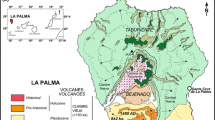Abstract
Intermediate calc-alkaline magma (52–65% SiO2) in western-central Mexico is the focus of this paper, and the typically porphyritic andesites (57–65% SiO2) form large central volcanoes, whereas basaltic andesites (52–57% SiO2) are less porphyritic, and they are found as cones and flows but are absent from central volcanoes. Several studies of experimental phase equilibria on these lavas relate water concentration to the phenocryst assemblages and to the degree of crystallinity, so that the abundance, composition and variety of phenocrysts can be used to constrain the amount of water dissolved in the magmas. Thus, the plagioclase-rich andesites of Volcan Colima, Mexico, become so as a result of decompressional crystallisation at ~950 °C (the pyroxene phenocryst temperature), and lose their dissolved water (2.5 to 4.5 wt% H2O) which is inversely proportional to the modal abundance of plagioclase. The feeding magma to V. Colima, North America's most productive central volcano, is represented by hornblende lamprophyre, a lava type without plagioclase phenocrysts which requires at least 6 wt% water to reproduce the phenocryst assemblage. Thus, degassing of the V. Colima magmas, and of those of the other central volcanoes in the western-central Mexican volcanic belt, contributes essentially all their dissolved water to the conduit or to the atmosphere. The source of this magmatic water is related to the source of the intermediate magmas. For some this must lie in the mantle, as the incorporation of hornblende-lherzolite nodules in a hydrous andesite with hornblende phenocrysts could only have occurred while ascending through the mantle. Consistent with a mantle source is the composition of the olivine phenocrysts in Mexican lavas with 10 to 5% MgO, which is in the mantle range of Fo88–92. Accordingly, basaltic andesites and andesites with >5% MgO are candidates for a mantle source. The equilibration of intermediate magmas with the mantle, as illustrated by the experiments of various workers, requires that the magmas be hydrous at pressure. An additional constraint is that the activity of silica in the mantle must be equal to that in the hydrous magma at equilibrium. Using published and new experiments to define RTlnγSiO2 in hydrous liquids, this quantity is shown to vary as a function of liquid composition (H2O, MgO, Na2O+K2O), and it approaches zero for quartz-saturated hydrous liquids. Using appropriate values of RTlnγSiO2 for three intermediate lavas, the amount of water required to equilibrate with an olivine-orthopyroxene mantle source is calculated, and within error indicates that only the most silica-rich magma is at water saturation in the mantle, in agreement with published experimental work. Hydrous intermediate magmas, ascending from their hornblende-lherzolite source regions (~1 to 1.5 GPa) along the hydrous adiabat, may not encounter any phase boundaries until 0.2–0.4 GPa because of the increase in the thermal stability of hornblende in water-undersaturated magmas. Therefore, the phenocryst assemblages of hornblende-free andesites equilibrate at low pressures. The virtual absence of basalt in west-central Mexico (<4 Ma) is considered to be related to the large increase in crystallinity found in isobaric hydrous experiments crystallising hornblende at pressures close to those at the base of the crust. As a large proportion of the ferromagnesian components of basalt is acceptable to hornblende, it does not take a significant cooling interval (~40–50 °C) below the liquidus for hydrous basaltic magma to acquire >50% crystallinity, evidently also an eruptible limit for V. Colima andesitic lavas. If the lower limit of water dissolved in Mexican intermediate magmas is accepted as that required for phenocryst equilibration (~6 wt% water), and the upper limit as saturation in the mantle source at 1 GPa (~16 wt%) then, with an estimate of the volcanic and plutonic magma delivery rate (km3/106 year) per km of volcanic arc, the flux of water returned from the mantle along the 35,000-km, global subduction-related arc system can be estimated. Measurements of the volcanic flux are woefully few, and estimates from Mexico, the Lesser Antilles and central America show a range from 4 to 20 km3/106 year×km which, if subtracted from the isotopically constrained continental growth rate, gives the plutonic flux rate. This suggests that, of the magma flux ascending to the continental crust, only about a fifth reaches the surface. If the dissolved magmatic water limits are coupled with the volcanic and plutonic emplacement rates, then the amount of water returned by magmatism to the crust is crudely in balance with that subducted.
Similar content being viewed by others
Author information
Authors and Affiliations
Additional information
Electronic Publication
Rights and permissions
About this article
Cite this article
Carmichael, I.S. The andesite aqueduct: perspectives on the evolution of intermediate magmatism in west-central (105–99°W) Mexico. Contrib Mineral Petrol 143, 641–663 (2002). https://doi.org/10.1007/s00410-002-0370-9
Received:
Accepted:
Published:
Issue Date:
DOI: https://doi.org/10.1007/s00410-002-0370-9




